Welcome to the week. Here are the most noteworthy items we came across in the past seven days.
They knew: Maybe not a huge surprise, but new reporting confirms that Ford and GM knew about the dangers of greenhouse gas emissions from their vehicles and not only did nothing, they worked to hide the truth and doubled-down on fossil fuel guzzling vehicles. (I will still never forgive Obama for bailing them out.)
“Diary of a new cyclist”: London resident Sarah Berry shared a heartfelt message to the people in cars who put her in danger.
E-bikes for clunkers: Smart program in Lithuania gives people a $1,200 subsidy for trading in an old car that they can put toward purchase of a new e-bike.
Gov’t issue bike tires: People in Oslo, Norway are so keen to keep riding in icy winters they gobbled up 4,000 studded bike tire subsidies in the first week they were available.
Advertisement
Harley’s e-bike: It’s not news that a non-bicycle brand has come out with an e-bike. What is news is how much better e-bike designs from non-endemic brands are getting. It shows how serious companies are taking the e-bike market.
The story of Rad: Excellent profile of Seattle-based Rad Power Bikes CEO Mike Radenbaugh shares his rise from battery-bike tinkerer to bike industry disruptor.
Scooter resurgence: Lime’s CEO says the pandemic-influenced cityscape has helped illustrate the value of e-scooters as a serious mobility option.
Safety for whom?: After NHTSA declared October “Pedestrian Safety Month”, the nonprofit America Walks had to inform them that much more of the focus needs to be on driving behaviors.
Vehicular violence run amok: In a weekend that saw several Trump truck caravans and many incidents of rampaging drivers, President Trump celebrated an incident on a Texas freeway when his supporters tried to ram another driver.
Tempt me Tempe: With 761 apartments and no car parking spaces, Culdesac Tempe is being called the first-ever carfree neighborhood in America built from scratch.
Tweet of the Week:
Earlier this year, we got to glimpse what air quality looks like with millions of cars off the road. As things begin to return, we have the chance to make a change. Taking the train is 83% cleaner than driving and 73% cleaner than flying…#AmtrakSustains pic.twitter.com/qEpbtJY46t
— Amtrak (@Amtrak) November 1, 2020
— Jonathan Maus: (503) 706-8804, @jonathan_maus on Twitter and jonathan@bikeportland.org
— Get our headlines delivered to your inbox.
— Support this independent community media outlet with a one-time contribution or monthly subscription.



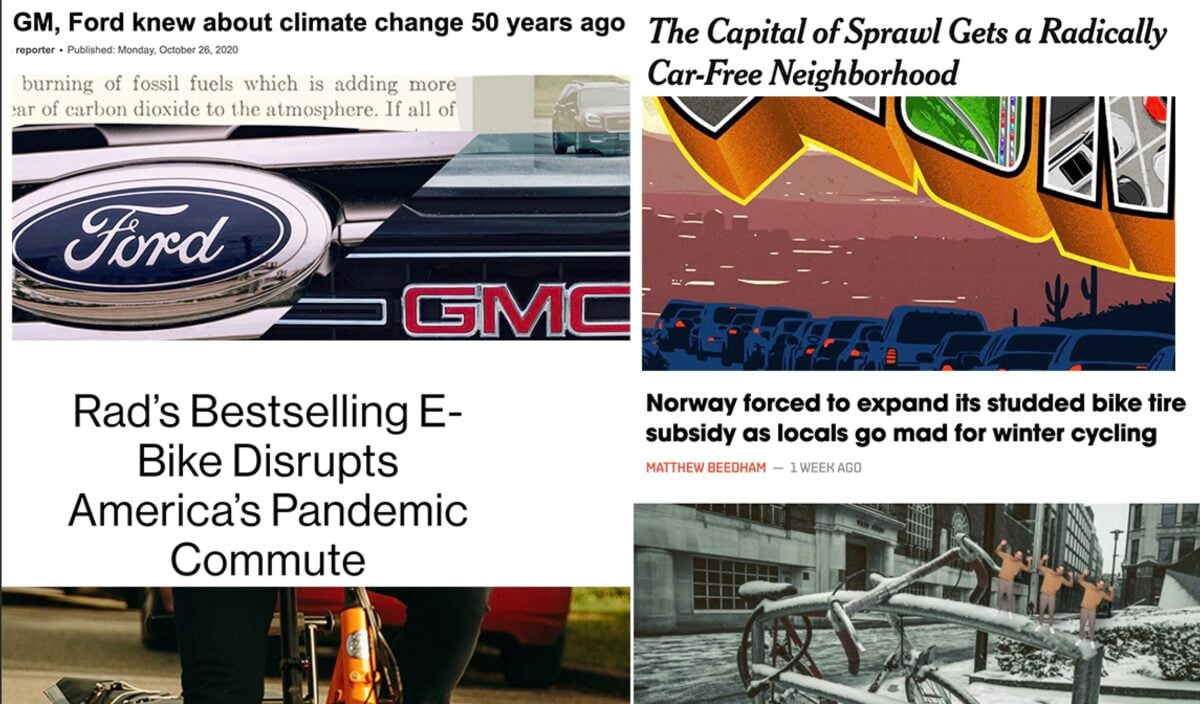
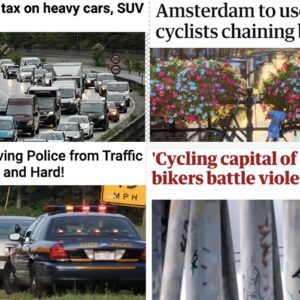
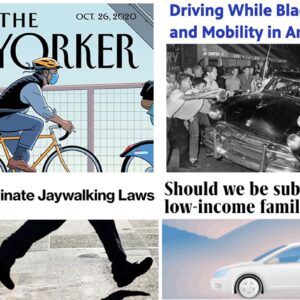
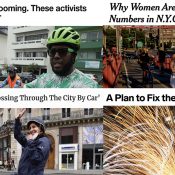
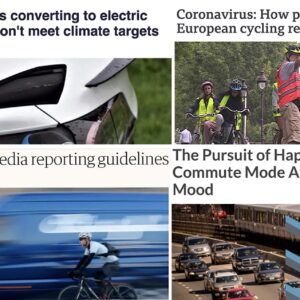
Thanks for reading.
BikePortland has served this community with independent community journalism since 2005. We rely on subscriptions from readers like you to survive. Your financial support is vital in keeping this valuable resource alive and well.
Please subscribe today to strengthen and expand our work.
Culdesac looks like any North American city but without city street – but it also seems to be designed to later have streets easily retrofitted without affecting building footprints. It’s a lost opportunity to create a truly permanent car-free community, like the medieval cities of Europe. And the author seems to totally unaware that much of the US was once upon a time developed without cars in mind – without cars in anyone’s mind for that matter, pre-1914 – but for the pedestrian, horse, and (later) bicyclists and public transit.
I would assume that fire departments and insurance companies have some minimum standard for emergency access. Even if the areas are car-free I’m sure they are required to include plans for emergency vehicles to get in and out of any part of the development.
More vehicular violence, and especially more threats of vehicular violence, mostly from people supporting a certain candidate. I’m more than a little concerned about what may ensue after the election – and heaven knows how it may turn out. Anyone who thinks they can predict the outcome is either insane or lying.
I will issue a warning, though, from Minnesota. It’s not as solidly Blue as the national media tell you. We may have the longest blue streak in America – 9 straight elections voting for the Democratic candidate – and it may end this year. Even in the oft-discussed scenario of a Biden victory by flipping Wisconsin, Michigan and Pennsylvania back into the blue column, Minnesota could act the spoiler, throwing the whole thing to Trump.
The reason Minnesota has always gone Blue – and the reason it may go Red this year – is the our northern mining region known as the Iron Range. Formerly a hotbed of labor activism and the deepest Democratic stronghold in the state, but no longer. Economically stagnant for decades, they’ve suddenly seen increased prosperity as Trump’s steel tariffs pushed up prices of domestic iron, and mines and mills have reopened. And Trump promises many more jobs, knocking down environmental regulations that have been blocking copper-nickel mines that threaten water quality in the pristine Boundary Waters, the most heavily used wilderness area in the country.
Not only does the Iron Range appearing to be going strongly Red this year, but turnout is massive – higher than turnout in metro areas across the country that otherwise offer hope for a Biden victory. I don’t think the statewide polls that show Biden up by several points are accurately accounting for the turnout up north. Maybe the revulsion many feel towards Trump is strong enough to offset the red shift up there, but I can’t say for sure. Also, a federal court just signaled on Thursday that they may disqualify late-arriving absentee ballots, which this year lean strongly Democratic.
I know there are a lot of other swing states to keep an eye on tomorrow night, but folks, keep an eye MN. We’re more of a swing state than most of the national media, relying uncritically on statewide polls, realize. Even Nate Silver hasn’t drilled into our weird intrastate regional shift. But we’re getting several visits per week from both candidates. They know something’s up here. I hope we can still deliver electoral votes for Biden, but as with everything there’s an awful lot of uncertainty this year.
Yes, but will the hardcore Trump supporters still turn up to vote if they have to wear a mask tomorrow?
https://kstp.com/minnesota-news/supreme-court-denial-keeps-mask-mandate-at-minnesota-polls-november-2-2020/5913725/
I suspect that in many of the places where Trump’s support is strongest, the ban won’t be too strictly enforced.
“In Minnesota, if a voter doesn’t have a mask, they will be offered one or offered curbside voting. If they refuse, the person can still vote, but faces the possibility of a fine up to $100 for violating the state’s mask mandate.”
It boils down to enforcement.
No one is going to get fined, at least in the rural counties. AFAIK the only fines issued, since the mandate started months ago, were a handful of people who threw parties or had it tacked onto more serious criminal offenses.
(side note to this side note: we are unique among our neighboring states in having a statewide mask mandate – and you can see how well that’s going for them – although there are some countywide mandates in neighboring states).
Looks like MN wasn’t that close.
That being said, if I was the grand poohbah of the Democratic Party this morning, I would have all my smartest messaging/policy people in the room with one question: “How do we improve our standing with rural (esp. white) voters?” Had there been Biden done between 5%-8% better in rural counties in Florida, Ohio, Pennsylvania, Michigan & Wisconsin, it would have been called last night. When your election strategy is dependent on every voter and their pets in 3 or 4 counties in a state, its not a strategy, its a hope.
Looks like my Iron Range hypothesis failed to pan out: even St. Louis county, home to much of the Range, stayed blue, outweighed by liberal Duluth at the other end of the county.
One of the reasons MN wasn’t that close is that liberal Hennepin County (most populous in the state, and home to Minneapolis as well as Ilhan Omar’s district) turned out in staggering numbers. While overall turnout was 78% statewide, close to a record but not quite, turnout in Hennepin County was a stupefying 92%. As I’ve always said, elections are about turnout.
How to improve our standing with rural white voters? It’s clear that nationwide, rural turnout was higher than expected. Rural people were fired up, and I think angry about a lot of things. Some of that is based on actual differences on the actual policy issues, but much of they’re angry about seems to be based on mischaracterizations (or outright misinformation), frequently about the other side. Yes, this is happening on both sides, but I don’t think symmetrically.
I think we have to start by first standing up for factual reporting. We can disagree all we want about how to interpret them or what to do about them, but the last few years have shown that if we can’t agree on the facts, we cannot find common ground. Our divisions will only continue to widen, and if Tuesday told us anything, it’s that they are still widening.
I currently live in rural MN. The county went 64% Trump. And that was slight decrease than 2016, believe it or not. Some of it is misinformation from Fox News. But I’m here to tell you, a lot of it is policy. Example: I’m a hunter and I do love firearms. (Guns are fun.) I see how the mainline liberal/Democratic “gun control” measures a) don’t actually help with gun violence and yet b) seemed to be tailored made to honk off rural people. They seem to be more about what firearms look scary, not which ones are actually more dangerous. The thing is, I’ve tried talking politicians about the better answer (permit to purchase) and because it doesn’t fit into the orthodoxy of gun control, they won’t even consider it. Even though nearly every country that allows personal firearms uses permit to purchase. (In fact, pistols in MN are permit to purchase.) And that is just one example.
Our divisions don’t have to widen. With good policy and better messaging it would be possible for many rural and urban voters to see eye to eye on things. Lets be clear, that means some “new to liberal voters” ideas.
On the guns issue in particular, misinformation IS a big part of the picture. We liberals simply are not coming to your guns. You will always be able to hunt. Full stop. The false narrative is just intended to scare and inflame people. (And on a personal level, I have multiple family members who own firearms, and who hunt, and have no interest in taking away their fun).
What seems to have been the biggest hot-button issue firing up rural Minnesota outside the Iron Range this year (“urban violence”, meaning both the rioting after George Floyd’s death, as well as the more recent crime wave misattributed to attempts at police reform) is definitely a situation of mischaracterization and misinformation.
But I agree that the Democratic Party also needs to figure out how better to appeal to rural Americans. Of course we have more in common than we realize. The party could start by rediscovering economic populism – but that would mean standing up to their billionaire donors.
Well… First, I’m pretty liberal myself, somewhere to the left of Karl Marx on many issues. 🙂 Second, some liberal politicians have said they are “coming for your guns”, Beto O’Rouke being the most obvious. Yes, I know he is wet behind the ears politically and kind of a dink, but he just said the quiet part out loud. You could not have any of the proposed gun control measures work unless you removed the existing stock of certain weapons. Third, to describe how current gun control dogma damages rural gun ownership is a long essay. But the Mini-14 is good example. Its a ranch rifle, and in nearly every farmer’s & rancher’s pickup truck east of Cleveland. Yet, politicians who find firearms scary always seem to write a law that would make a Mini-14 illegal completely by accident because they don’t understand firearms and don’t care what the downstream effects are.
And the same conversation could be had with things like Medicare for All, which should be passed yesterday. But it makes rural people nervous because the closest hospital is 20 miles away down gravel roads and the next one is 40 miles away. So the fear is that due to efficiency, some bean counter could force them to go a lot further for a hospital. Which matters in life or death scenarios.
And that is sort the point here. Saying to rural voters, “Yeah, you just watch too much Fox News,” dismisses real issues that the policy makers in the Democratic Party aren’t listening to. If you want to change things, you need a broad base of support. And telling a third or more of the country their concerns/issues are made up isn’t going to get them on board.
They knew: This happened with Big Tobacco, and they ended up paying a lot of money and we have warning labels on their products. Can we expect the same from the car companies now?
Interesting we’re finding out that not only did GM and Ford know for a long time of science that was bad news for them, and tried to suppress it, but that this behavior goes back much further than we thought. Much like tobacco, lead paint and big sugar, these companies knowingly misled the public for decades about the dangers of their products.
Sowing uncertainty, publicly attacking scientists and funding studies cooked to show results contrary to their own scientists’ findings.
Science is real. But too often manipulated by big money.
Don’t worry, Tempe does not tempt me.
I like the train tweet, but they leave out the fact that we can still run trains when the oil is gone (no longer economic too get out of the ground) and what we have are a transportation system running on wind, solar and hydro. Commercial aviation is strictly a creature of cheap abundant fossil fuels. The sooner we get going on creating efficient passenger rail the less likely we will be have to travel on stage coaches or the like.
Aviation and shipping can be carbon neutral through the use of synthetic fuels. This technology was proven out on a large scale a decade ago but killed by cheap oil prices. It turns atmospheric carbon back into the target fuel, gasoline, diesel, jet fuel, ethanol whatever. The energy input is direct sunlight and it uses a biological catalyst which is the secret sauce and what makes this a breakthrough which wasn’t available prior to 2000.
There is only ONE reason for the world’s economy to be producing carbon at this point and that is to enrich fossil fuel investors.
I used to read popular mechanics too. 50 years ago it was a sure thing we would have flying cars, useful jet packs, gas turbine cars and fusion powered electricity “ too cheap to meter”. Back then we actually had supersonic passenger planes, helicopter service from Manhattan to JFK and people walking on the moon. Now we can’t seem to make disinfecting wipes, planes that don’t crash, or old fashioned fission power plants. Those things seemed neat at the time but we could not afford them, and we will not be able to afford the size complexity and side effects of trying to gather up enough air and zap it with enough sunlight to make enough jet fuel to get to Vegas.
So this is the problem with the internet. This may be the first time you learned about this. You have no idea whether the person conveying the information to you is an idiot or what their level of expertise is and it does sound like pie in the sky free energy stuff. So, I understand the skepticism.
However, this is proven technology that was scaled to production. There were several companies undertaking similar technologies and touting profitable operations at oil >$80 a barrel. Even if it was $100, we have seen that this is not high enough to adversely impact the world economy. Those are very realistic prices and once you factor in that this is carbon neutral energy, it’s totally worth it.
Joule Unlimited was the most prominent of the companies doing this and you can read about them here. https://en.wikipedia.org/wiki/Joule_Unlimited
The point is that we can dispense with the self flagellating idea that we must somehow abandon many modern technologies at the altar of environmentalism. We absolutely need to make changes, drastic ones and quickly, that’s for sure, but literally in the last 2 decades we have developed technologies that create a way to abandon fossil fuels entirely while continuing to meet our energy needs. However, our way to a sustainable future is being blocked by ancient dragons.
The Navy has been experimenting with this technology to produce aviation fuel at sea (using electricity from nuclear powered ships). As I recall, the cost for them was about $8 per gallon, which was comparable to what it cost to have conventional fuel delivered at sea.
It’s interesting that the military is out front in taking a pragmatic view of energy use and fuel supplies. I guess their mission doesn’t allow choosing pretension over observable reality. That’s not to say that I support the amount of resources we put into our military or everything they do. Every jet fighter takeoff from the local airport represents multiple tons of fuel turned into smoke and noise (a fighter plane with 1000 pounds of fuel on board is basically out of gas).
It’s a matter of national security that the military is prepared for fuel shortages. Whether or not national security is something you believe in is not important. From their perspective, it is rationalized as contingent planning. They aren’t necessarily trying to “go green”.
You share a common misconception about energy and technology. Most people think that humans created nifty technologies then powered them with whatever energy source was handy. In fact the reverse is true. When our only energy was the sun gathered in the form of agriculture only a certain degree of complexity and technology could be supported. For instance it is generally regarded that the highest cultural and societal sophistication that can be maintained on a solar energy budget ( without imported energy, resources or slaves) is that of Tokugawa era Japan. Once more concentrated energy sources were found ( first coal then oil) they enabled the creation of technologies to use them. So for example, even if Da Vinci’s design for a helicopter had been perfect, and the materials available it would not have been useful until oil was discovered. Mother nature concentrated millions of years of solar energy in to a cheap, energy dense and mobile fuel supply in petroleum. Rather than wisely rationing this energy jackpot to build a world civilization that could be sustained on the solar budget after oil was gone we chose to squander it in a few short years flying to Las Vegas, driving SUV’s in circles and hauling blueberries from Chile. Once this one-time jackpot is gone, so is most of the technology. We humans don’t have a right to cell phones, highways or plane travel and we will most likely find that out too late. Desperate attempts to turn brackish pond water in to jet fuel using “magic bio catalysts” will not provide the net energy to power our complex society let along fly people to Oahu on vacation. They will end the same way as the Nikola Battery Truck, which was also “Proven” but only worked when it rolled downhill. Cheer up though because the one technology that we will have once the oil runs out is pedal powered bikes.
The problems we are presented with have solutions but rather than working on those we have one side which denies the problems and the other which denies the solutions.
Our current pedal-powered bikes require lots of heavily refined aluminum alloys, steel alloys, brass nipples, stainless steel, plastics of all sorts, leather from dead animals, natural and synthetic rubbers, wiring and electronics, lots of cheap labor (both from overseas for manufacturing frames and parts, plus domestic for assembly and maintenance), shipping by both sea, land and air (especially parts), lubricants, trade agreements with dictatorships, all of which use fossil fuels to not only make stuff but also to smooth out the process. And then there’s carbon fiber, plastic money, and credit…
The NYT reporter on the new TOD development in Arizona should pay a visit to Orenco Station, an empty cornfield when MAX opened in ’98. Which reminds me that very smart Joe Cortright should recognize that all that under utilized land along Barbur in the SW Corridor will fill in with lots of housing, much of it affordable, once MAX opens there. Just what we need. If you don’t believe it, take a look at N. Interstate. Vote YES on the Metro transportation measure!
Every time I take the train to DC, it passes through the northern Virginia suburbs of Arlington and Alexandria, cities built on hillsides overlooking the Potomac. Its profile looks a lot like SW Portland, but with huge clusters of 30-60 story tall apartment blocks centered around each subway stop – it’s very impressive-looking especially given how low the rest of the DC skyline is (more or less limited to 10 stories max.)
I used to love flying in and out of National Airport…so danged convenient.
Apparently the Silver Line to Dulles is expected to open next summer.
http://www.dullesmetro.com/
All that development and somehow MAX ridership is still declining while SOV trips increase and congestion and pollution skyrocket.. High cost commuter rail doesn’t work
Not when you subsidize driving, it doesn’t.
My driving subsidy check was lower than expected this year.
Soros had a lot of people to send checks to.
Booo! False equivalency!
Are you sure it’s not a straw man?
Well, the Metro measure has several road expansion projects, so that’s not going to change is it?
Ever heard of COVID fear. It will subside and the proven safer and more efficient rail service will still win out.
When COVID has receded I expect the Orange Line to finally start meeting its service goals.